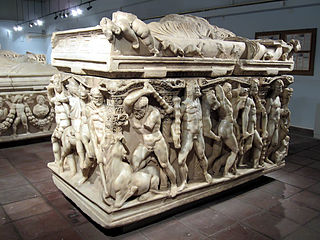Related Research Articles

Parthenia was a Roman–Berber town in the former Roman province of Mauretania Sitifensis, the easternmost part of ancient Mauretania. It was located in what is now northern Algeria.
A titular bishop in various churches is a bishop who is not in charge of a diocese. By definition, a bishop is an "overseer" of a community of the faithful, so when a priest is ordained a bishop, the tradition of the Roman Catholic and Orthodox churches is that he be ordained for a specific place. There are more bishops than there are functioning dioceses. Therefore, a priest appointed not to head a diocese as its diocesan bishop but to be an auxiliary bishop, a papal diplomat, or an official of the Roman Curia is appointed to a titular see.

The Roman Catholic Diocese of Beverley is an historical diocese of the Roman Catholic Church in England. It took its name after the town of Beverley in the East Riding of Yorkshire, although the episcopal see was located in the city of York. The diocese was established in 1850 and was replaced by two dioceses in 1878: Middlesbrough and Leeds. It was restored as a titular see in 1969.
Bergule or Bergula or Bergoule, also Bergulium or Bergoulion (Βεργούλιον), also called Bergulae or Virgulae, was a town in ancient Thrace, which was in later times called Arcadiopolis, Arcadiupolis, or Arkadioupolis (Ἀρκαδιούπολις). It was noted by Ptolemy, and inhabited during Roman and Byzantine times. Under the name Arcadiopolis in Europa it was the seat of a bishop; no longer a residential see, it remains a titular see of the Roman Catholic Church.

Tiberiopolis was a town in the Roman province of Phrygia Pacatiana, mentioned by Ptolemy, Socrates of Constantinople and Hierocles. At various times, it was considered as part of Phrygia, Isauria, and the late Roman province of Pisidia.
Drizipara now Karıştıran (Büyükkarıştıran) in Lüleburgaz district was a city and a residential episcopal see in the Roman province of Europa in the civil diocese of Thrace. It is now a titular see of the Catholic Church.

Quaestoriana was an ancient civitas (town) and bishopric in Roman Byzacena(North Africa). Quaestoriana is also a suppressed and titular see of the province of Byzacena in the Roman Catholic Church. The current bishop is Manuel Antonio Valarezo Luzuriaga. Its present location is in modern Tunisia.
Anineta, also known as Aninetum or Anineton, was a town of ancient Lydia or of Caria, and later of the Roman, and Byzantine empires, located in modern Turkey, the site of an ancient bishopric in and was an important site early in christianity. Anineta remains today a titular see of the Roman Catholic Church in the ecclesiastical province of Ephesus. In addition it minted coins bearing the legend Ἀνινησίων.

Satala or Satala in Lydia was a Roman era city and Bishopric in ancient Lydia.

Utimma was an ancient city in the Roman province of Africa Proconsularis during the Byzantine and Roman Empires. the exact location of Utimma is lost to history but it is believed to be between Sidi Medien and Henchir-Reoucha in Tunisia.

Castellum Minus was an ancient city located in the Roman province of Mauretania Caesariensis in today's northern Algeria. The ancient city is identified with ruins near Coléa, Algeria,(at 35.3877778° latitude and 0.1416667° longitude).

Gunugus or Gunugu was a Berber and Carthaginian town in northwest Africa in antiquity. It passed into Roman control during the Punic Wars and was the site of a colony of veteran soldiers. It survived the Vandals and Byzantines but was destroyed during the Muslim invasion of the area.

Nasbinca was a Roman town of the Roman province of Mauretania Caesariensis. The location of Nasbinca is now lost to history but it was in today's Algeria. The town seems to have survived through late antiquity till at least the Muslim conquest of the Maghreb.

The Diocese of Iunca in Mauretania is a suppressed and titular see of the Roman Catholic Church.

Numida was an ancient Roman town in the Roman province of Mauretania Caesariensis. It was located in modern northern Algeria.

Tamada was an ancient Roman–Berber civitas in the province of Mauretania Caesariensis. The town lasted through the Byzantine Empire, Vandal Kingdom and Roman Empire into late antiquity, until at least the Muslim conquest of the Maghreb in the 7th century.
Ceretapa or Keretapa, also called Diocaesarea or Diocaesareia or Diokaisareia (Διοκαισάρεια), was a Graeco-Roman town of Phrygia Pacatiana. It minted coins bearing the demonym Κερεταπεύς. The coins also show that there was near it a river or fountain Aulindenus. It was a bishopric with Silvanus representing the city at the Council of Ephesus, 431. No longer the seat a residential bishop, it remains a titular see of the Roman Catholic Church.
Lupadium or Loupadion was a Graeco-Roman town of ancient Mysia. It minted coins during the Byzantine period. It was a bishopric; no longer the seat a residential bishop, it remains a titular see of the Roman Catholic Church.
Prymnessus or Prymnessos, or Prymnesus or Prymnesos (Πρύμνησος), was a town of ancient Phrygia, inhabited during Roman and Byzantine times. It was the see of a Christian bishop. No longer the seat of a residential bishop, it remains a titular see of the Roman Catholic Church.
Urima or Ourima, also known as Antiochia ad Euphratem and Arulis, was a town on the Euphrates River of Classical Anatolia, inhabited from Hellenistic to Byzantine times. It was in the late Roman province of Euphratensis. Urima was the seat of a bishop; no longer a residential bishopric, it remains a titular see of the Roman Catholic Church.
References
- ↑ Maiuca at www.gcatholic.org.
- ↑ Pius Bonifacius Gams, Series episcoporum Ecclesiae Catholicae, (Leipzig, 1931), p. 466.
- ↑ Stefano Antonio Morcelli, Africa christiana, Volume I, (Brescia, 1816), p. 211.
- ↑ Annuario Pontificio 2013 (Libreria Editrice Vaticana, 2013, ISBN 978-88-209-9070-1), "Sedi titolari", pp. 819–1013
- ↑ Cheney, David M. "Maiuca (Titular See) [Catholic-Hierarchy]". www.catholic-hierarchy.org. Retrieved 2018-01-29.
- ↑ Le Petit Episcopologe, Issue 147, Additions/Corrections (front)
| This article about a location in Algiers Province is a stub. You can help Wikipedia by expanding it. |